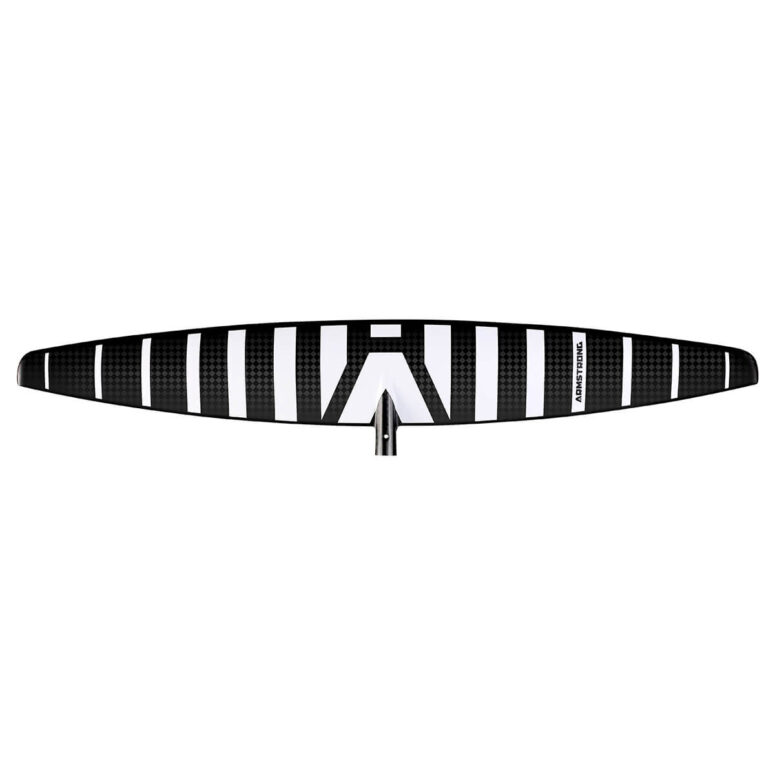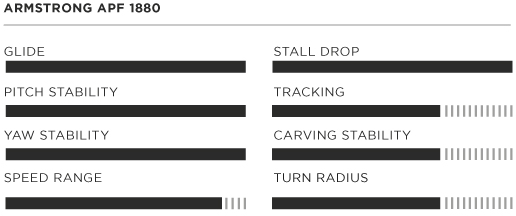

When you purchase gear through links on our site, we may earn a small commission. Here’s why you can trust our tests and our affiliate partner.

While the Armstrong high aspect series have been and still are great pumping foils, Armstrong has hit the pump and flatwater game head on with their new APF series. Aptly called the Armstrong Pump Foil, the 1880, 1675, and Pump 202 tail are here to redefine pump foiling for beginners and experts. Engineered in collaboration with aerospace engineer and renowned aftermarket tail designer, Chris Porter, this unique wing was designed with the clear objective to provide progression for flatwater pumping, personal records, and the first tastes of downwinding on small bumps. The key to unlock the potential of this series was to offer significantly low stall speeds and pitch stability without losing maneuverability for wings their size.
For our testing, we used the APF 1880, which Armstrong advises for advanced pump foilers under 90kg and progressing riders over 90kg. Even though this 1880cm front wing has a bold span of 1302cm, it has a surprisingly lower aspect ratio than you’d think, at 9.2:1. We paired the APF 1880 with its complementary Pump 202 tail and extra stiff 795 Performance mast. We tried it on a variety of prone boards, as well as a current generation narrow SUP downwind board.
We tested this foil in a range of conditions, from flat water to small waves and micro wind bumps. If you’re not used to riding a “pump wing” it's a good idea to anticipate that you’ll experience a different foil behavior than what you’re used to for surf or wing foiling. The first thing we noticed was how much initial lift the APF 1880 had. Any slight forward movement with the foil through the water would create lift. A strong indication of a low stall speed, this enabled us to do dock and rock starts without having to run up to speed. This early lift also makes the foil pump more off the front foot, allowing us to put our hands further forward on the board when setting up and match its balance point. While pump foils tend to be very spanny and track with a mind of their own, usually resulting in total loss of maneuverability, the 1880 was surprisingly easier than expected to control and bank turns with.
The cadence of the pump is also intuitive, allowing you to lightly bounce effortlessly to maintain the ideal height on the mast and comfortably hold a cruising speed. Due to the higher camber profiles of both the front and back wings, the APF won’t be moving with the same overall speed as the high aspect series, but this actually allows riders to focus on pump technique. This grants the glide and time to either gently pump off the calves or focus on isolating different muscles without early fatigue. We also found the APF 1880 to be exceptionally pitch stable, which helped us concentrate on getting into a smooth rhythm and cover more distance with less effort.
After testing at the docks, we threw the APF set on our downwind SUP to practice flat water pop ups. Unlike other wings we’ve used, you immediately feel the sensation of lift with the first few paddle strokes. So instead of focusing on being back footed and scooting back on the board to get lift, we found that maintaining the initial stance and putting more weight on the front foot while paddling up to speed helped to smoothly lift out of the water with significantly less strokes and effort than thinner high aspect foils. After dialing the flat water pop up, we noticed that the APF would pick up bump energy from even the smallest waves and wind bumps. Being able to ride the foil at the slow speeds of lightwind chop let us milk every bit of energy from ripples that we previously thought unrideable. This made it fun to practice downwind in lakes or bays that don’t usually get fast moving or large windswell bumps.
The Armstrong Pump Foil 1880 is a remarkable addition to the world of pump foiling, setting a new benchmark for efficiency and stability. Whether you're an experienced or an aspiring rider, embrace the glide, push your boundaries, and experience next level of pump and downwind training with the Armstrong APF series.
